Early Verdict
This is a very appealing prospect for enthusiast buyers looking for a capable barebones unit with a relatively good amount of upgrade potential.
Pros
- +
Very capable barebones unit
- +
Impressive upgrade potential
- +
Good value for money
Cons
- -
There are cheaper rivals out there
- -
Not as compact as some competitors either
Why you can trust TechRadar
We've had our fair share of ultra-small personal computers, from very well-known ones (HP's 260 G1 for example) to the downright anonymous (like the Pipo X7).
These tiny machines have shrunk further, and have also come down in price significantly making them even more attractive to the dwindling number of customers still interested in so-called Wintel computers – devices powered by Intel processors and using Windows.
Intel saw that niche a few years ago and, just like it did for netbooks and Ultrabooks, decided that a framework was necessary in order to make it a success.
This is how NUC (Next Unit of Computing) came to life but unfortunately its birth coincided with a platform shift that saw customers move to smartphones and tablets as their main devices.

The NUCBU01201 (also known as the XPC Nano Ultra Slim NC01U) shares a lot of features with its rivals but has a couple of interesting capabilities that set it apart.
This device is built by Shuttle, a Taiwanese manufacturer that was popular back in the late 90s and early 2000s thanks to a range of small form factor (or SFF) cube-shaped chassis designs and computers, and the NC01U perpetuates Shuttle's commitment to tiny computers in an extreme way.
The unit that was sent to us is powered by an Intel Core i5-5200U and comes with 4GB of RAM plus a 128GB SSD. It retails for around £290 but it is also available as a barebones without any system memory or on-board storage for as little as £105 excluding VAT and delivery at Lambda-tek.
Sign up to the TechRadar Pro newsletter to get all the top news, opinion, features and guidance your business needs to succeed!
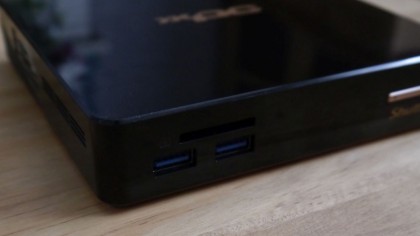
That's a decent price for a system powered by an Intel Celeron processor – but not any old Celeron model. This one is a Broadwell-based 3205U, rather than its N-series cousins that are at the core of many competing devices. Shuttle, it seems, wanted to go for something a bit more powerful compared to rivals, even if it turned out to be more expensive and less power-efficient.
This is a sweet spot that sits squarely between what you'd expect from Braswell parts and full Core i3/i5 levels of performance which will entice an interesting type of audience: DIY enthusiasts on a moderate budget who aren't afraid to tinker but still want the best value for money.
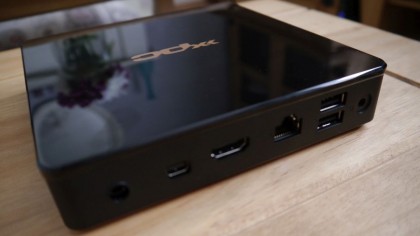
The XPC Nano is small but not as tiny as some of its competitors, for example Wintel HDMI dongles like the Intel Compute Stick. Visually, it looks like a slightly bigger Apple TV but in black with champagne rose accents. It measures 141 x 141 x 29mm, which translates into a volume of just under a pint.
A power button, power LED, HDD LED, two USB 3.0 ports and one SD card reader can be found at the front. The back panel houses an HDMI port, a Mini DisplayPort, two USB 2.0 ports, a Gigabit-capable Ethernet port, one audio port and a serial/RS232 one.
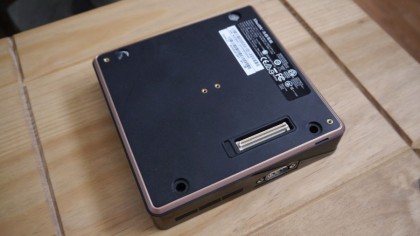
Flip it over and you will find a proprietary connector that allows it to connect to a docking station for even more upgrade capabilities. That may even include a discrete GPU should you want to use it for gaming purposes.
As for the top of the device, that's adorned with the XPC logo printed on a piano black panel. The entire system is powered by an AC adaptor.
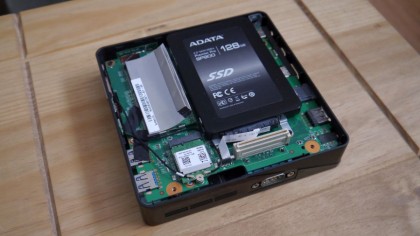
Opening it for upgrades is easy as well – two standard screws secure the bottom panel. Removing them gives you easy access to two memory slots (taking up to two DDR3L memory modules), a 2.5-inch internal drive bay for SATA drives and an M.2 PCIe-based slot which is far more capable than the eMMC modules usually found on entry-level devices. As expected you also get Wi-Fi (802.11ac) and Bluetooth 4.0; accessories include a stand and a VESA mount.
Sadly, the entry level Celeron 3205U CPU doesn't support 4K resolutions which means that you will have to settle for full HD via DisplayPort (plus you can always add another monitor via HDMI). The Core processors though will do 4K flawlessly.
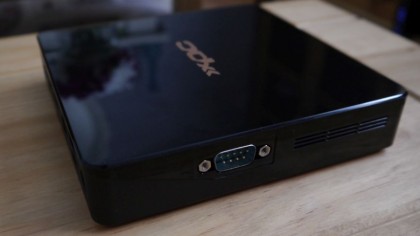
We were also surprised by the inclusion of a legacy serial port which confirms that Shuttle aims for a much broader audience with a clear nod to the digital signage market. Add in a three-year standard warranty and you've got a pretty good package for the price, especially if you want to do a bit of DIY by yourself.
Early verdict
We didn't perform any tests since the aim of this hands-on was to check out the device and not the extra components that it houses. Bear in mind that the XPC Nano is geared mostly towards the enthusiast market where its appeal as a capable barebones unit will be what seals the deal.
And boy does it succeed here – as long as you don't expect workstation performance from this pint-sized box, that is. You will certainly be able to get a cheaper barebones PC but it is likely that you will make concessions when it comes to size or upgradability.
- Also check out our Top 10 best business desktop PCs of 2016

Désiré has been musing and writing about technology during a career spanning four decades. He dabbled in website builders and web hosting when DHTML and frames were in vogue and started narrating about the impact of technology on society just before the start of the Y2K hysteria at the turn of the last millennium.
What is a hands on review?
Hands on reviews' are a journalist's first impressions of a piece of kit based on spending some time with it. It may be just a few moments, or a few hours. The important thing is we have been able to play with it ourselves and can give you some sense of what it's like to use, even if it's only an embryonic view. For more information, see TechRadar's Reviews Guarantee.
